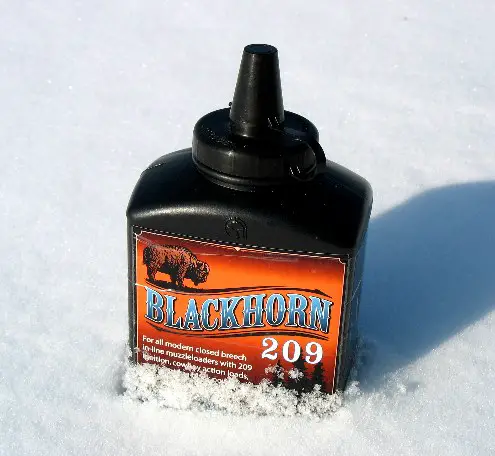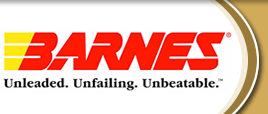


A Blackpowder Breakthrough?
Western Powders' BLACKHORN 209

Inline muzzleloading has had few really true improvements in the propellant department over the last six years or so. Sabots are better, bullets have seen improvement, but aside from the Savage 10ML-II and its use of smokeless that shotgunners knew was an obvious step forward over a hundred years ago, muzzleloading propellants have come up short in one way or another. We have made some unfortunate choices, opting for poorly packaged moisture-sucking pellets that begin to loose their potency as soon as they are exposed to humid air, and still may foul and rot our barrels. We apparently opt for convenience over good, and we make some strange choices in equipment: we claim that cheap is what we want, we seem to enjoy buying cheap muzzleloaders . . . and then, we make the worst possible decision when it comes to propellant; that being opting for the sales pitch of "magnum" muzzleloading and the take three pellets and call me in the morning routine.
Pellets are the worst way to work up loads, and at 33 shots per box for our magnum expedition . . . we may be forking over a dollar a shot for inaccuracy, corrosion, and crud rings. On top of that, we need to lick patches for any hope of consistent bore conditions, and still need to rush to clean our guns every time we shoot them. Somehow, we still seem to think that putting water in a rifle barrel is somehow an acceptable practice. "Cleaning up with just water" should ring alarm bells to those that understand that if it is water-soluble, it likely sucks moisture like a sponge holding it inside our barrels-- right where we don't want it. That is not particularly attractive in itself, but when the moisture is combined with heavy fouling crud rings and corrosive residue, barrels get ruined if set aside for long. So, we pay a premium for the "convenience" of pellets, paying through the nose-- and waste our time cleaning our convenient little pellets popper or risk the destruction of our muzzleloaders if we neglect them.
Yet, with all the clear negatives associated with Triple Se7en, it still is a popular choice. As cited in http://www.chuckhawks.com/black_powder_substitute_roundup.htm , it is the "available" solution, gives better velocities than Pyrodex, far better velocities than the horrible American Pioneer / Shockey's Gold stuff, and is far more consistent than the gravel textured APP / Shockey's Gold as well. The new propellant introductions have been tremendous disappointments again and again, though hope springs eternal. Goex promised improved American Pioneer, but failed to improve it. Now, it seems that Goex "Pinnacle" has faded from view. Black Mag3 was the pick of the 2006 tested litter but vanished from the scene almost immediately after they started making it properly, joining the faint echoes of Black Canyon and Goex CleaRshot that burned far more consumers and distributors than they did deer.
What is good about Triple Se7en FFg is its availability, consistency, and velocity. That has trumped its multiple other problems such as the crud ring, heavy fouling, the need to spit patch between shots, and its intermittent ability to seize breechplugs. Triple Se7en has been a resounding success, giving rise to its own set of "accessories" just to fight its problems: Triple Se7en primers, exotic bore cleaners, and a new focus on "EZ Load" sabots, though it was never the sabots that made things harder and harder to load, it was trying to push them through all the T7 fouling in the first place that gave people the Excedrin headaches. Well, it looks like Triple Se7en is finally obsolete, because now we finally have a hassle-free, consistent blackpowder replica powder that exceeds blackpowder and Pyrodex performance from a legitimate and respected company; Western Powders. Crud rings, water, stuck breechplugs, corrosion, and licking cotton patches are now obsolete along with Triple Se7en. It is about time. I certainly cannot say that Triple Se7en "does not work," it does and has for me. The fouling shot in the morning of the hunt, the firing and cleaning at the end of the day is something I've dealt with for some time. The constant discarding of partial pellet packs and partial bottles of T7 is part of the regimen if you want fresh powder performance.
Blackhorn 209 was trademarked by Western Powders on October 20, 2007, and is scheduled for general availability in March, 2008. I'll include some of my original testing notes; I have been assured by Western Powders / Accurate Arms that the actual released product is identical in performance to what I have been shooting.
"Standard Winchester 209 shotshell primers were used throughout. Baseline data was established at 41 degrees F. ambient using Knight / Barnes 290 grain EZ Load PBT (blue sabot) and Barnes Spitfire TMZ 250 (yellow sabot) saboted bullets and 100 gr. volumetric BH209.
290 grain sabot: 1722 - 1741 fps
250 grain sabot: 1841 - 1856 fps
The chronographs were verified before and after the shooting with established 1200 fps .22 LR ammo.
All powder charges were volumetrically measured using a T/C U-View powder measure, set to 100 grains. By Lyman electronic scale, this equates to 66.8 grains of actual weight.
I did no swabbing at all between shots, and noticed no significant increase in loading pressure shot to shot. Clean-up after shooting was done with Montana X-Treme "Cowboy Blend," it was very easy taking only a couple of patches.
I spent no time examining the kernels under a microscope, but a cursory glance gave me they were hollow extruded tubes. The grain structure appears more resilient than Pyrodex / Triple Se7en, with the ramrod coming to an abrupt stop upon seating rather than having a crunching effect at the end of travel. I had no issues metering the powder with the T/C powder measure; some of the grains did adhere to the side and need a quick tap to free--but, that's it."
Since that time, not a great deal has changed. My supply of the powder is far from unlimited, but it has been tested with the Thompson Encore, Savage 10ML-II, T/C G2, and a variety of Knight rifles. The velocities by weight of powder charge are as good as has been ever offered to the inline muzzleloading community: the better than 1700 fps from 66.8 grains by weight of Blackhorn 209 pushing a 300 grain sabot is better than the historical averages from 101.3 grains by weight of Goex FFg (1468 fps) 72.5 grains by weight of Pyrodex RS (1580 fps) and 74.2 grains of Pyrodex pellets (two pellets, 1570 fps). All of these loads approximate "100 grains volumetric." What that might mean to the individual is contingent on the brand of black powder measure they use, and how they personally measure the powder. These numbers are representative of the Thompson U-View powder measures I use most often. A more efficient powder, in this case Blackhorn 209, offers some lessening of recoil as well-as powder mass is part of free recoil.
I would imagine, but cannot say, that Western Powders will use what has become convention in the blackpowder substitute marketplace, designating 100 grains by volume as the maximum charge and letting the individual manufacturers designate loads as they see fit. Based on the pressure curves I've examined (direct pressure readings from a Piezo transducer fed into a Kistler charge amp/peak meter) I have no problem personally using this powder volumetrically in place of Triple Se7en FFg, as the pressures generated are generally lower.
In my mysterious and borderline clever way, I have determined from the name of Blackhorn 209 that this propellant is designed for use with standard 209 shotshell primers, such as the Winchester W209 or the Federal 209A-not the double or triple priced "muzzleloading primers." Forget the gimmicks of small bore rifle primers, or anything but standard full-power 209 shotshell primers. When you pull the trigger, the crud left in your bore is from filthy T7 or filthier Pyrodex - not from your primer. The ignition point of Blackhorn 209 makes it safer to use, handle, and store than blackpowder many so-called subs . . . using standard 209 shotshell primers will give you the best results.
Invariably, accuracy questions arise with a new propellant. Well, the best way I can describe Blackhorn 209 is that it shoots to the limit of your individual sabot, bullet, and rifle-- and the nut behind the butt, of course. When I flinched properly on a calm day, I was able to get several 3/4 in. 100 yard groups out of a Savage 10ML-II and Barnes Originals with MMP Orange sabots. It also did well with TMZ 290 Barnes, traditional Barnes 300 gr. MZ-Expanders, and Hornady .458 #4500 HP bullets with orange MMP .458 / 50 sabots. On some gustier, windier days I managed 1-1/2 inch to 1-7/8 groups with the same load array. 100 grains of BH209 (volume) and a Barnes TMZ 290 is more than you need to take most North American game out to 160 yards or so holding center mass; the TMZ 290 and the Barnes Original remain a couple of the best flyers, with more terminal performance than could be hoped for. One 10 oz. bottle of BH209 gives you more shots than $65 worth of Triple Se7en three pellet loads, with no crud, no immediate cleanup, and no corrosion. The shelf life of Blackhorn 209 is indefinite, properly stored in a sealed container many years of full performance. This is in stark contrast to Triple Se7en that grabs moisture immediately. The engineers at ATK / Federal, while developing their Fusion primer, found that "Any primer is fine with dry pellets. It's when the T-7 pellets soak up 7+% moisture that ignition becomes critical." It is this moisture grabbing ability of T7 that degrades performance, a property thankfully not shared by BH209.
By virtue of the consistent bore conditions with no swabbing and consistent shot to shot velocities, BH209 handily exceeds what can be accomplished with any other "bp" sub in shot-to-shot no swab accuracy. The residue is light soot, the sabot acts as a wiper. Load and shoot, load and shoot presents no problems-you might want to dry patch or run a dry "bore wooly" or mop down the barrel every 20 shots or so, your choice. Clean your gun when you feel like it-a couple of wet patches of Montana X-Treme "Cowboy Blend" or good old Hoppe's #9 does the trick.
The litany of features and benefits is quite a list; goodbye to crud, goodbye to corrosion, good bye to bad shelf life, good bye to cotton mouth, good bye to water in your barrel, and goodbye to frozen, cemented breechplugs. Load and shoot, load and shoot . . . have fun, and enjoy the outdoors.
Congratulations to Western Powders / Accurate Arms for finally giving inline muzzleloading hunters and shooters a high-performance propellant that helps gets the fun back into muzzleloading. The only thing I can't help you with is the wait; after March, 2008, you can grab a couple of bottles and prove it to yourself, the only proof that really matters. I'm not big on predictions, far preferring to foretell the past than predict the future. However, I can't think of a single reason anyone would suffer going back to "Teenage Crudland" after trying Blackhorn 209. I know I won't; I don't believe you will, either.
-- © Copyright November, 2007, by Randy Wakeman
Copyright 2007 by Randy Wakeman. All Rights Reserved.




